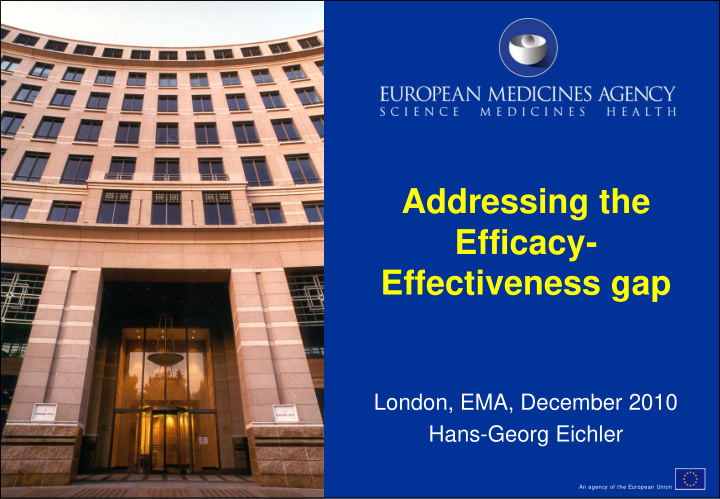



Addressing the Efficacy- Effectiveness gap London, EMA, December 2010 Hans-Georg Eichler An agency of the European Union
Efficacy versus effectiveness Efficacy is the extent to which an intervention does more good than harm under ideal circumstances Effectiveness is the extent to which an intervention does more good than harm when provided under the usual circumstances of health care practice Definitions by the EU High Level Pharmaceutical Forum (Oct 2008) Efficacy >> Effectiveness 2
3 after What does, and what licensing � does not change? ? before �
Case study: Acomplia (rimonabant 20 mg) Jun 2006: approved for obesity and over-weight patients. (“effect was moderate and of clinical relevance for 20-30% of patients”) 4
Case study: Acomplia (rimonabant 20 mg) Jan 2009: marketing authorisation withdrawn in light of post-approval data (“new data indicated a shorter duration of treatment in real life and a reduced beneficial effect… risk of experiencing the adverse mental effects are higher in patients with comorbidity”) 5
The efficacy - effectiveness gap: examples • Mibefradil (Posicor) • Cerivastatin (Lipobay, Baycol) • Rimonabant (Acomplia) • Varenicline (Champix/Chantix) • Metoclopramide (Maxolon et al) • …. 6
7 Can we conceptualise the efficacy - effectiveness A problem of variability gap?
Sources of variability in drug response Biology Behavior Genomics Environment Physician Patient prescribing adherence Patient’s Co-morbidity, Inappropriate Poor adherence genomic makeup baseline severity prescribing, to prescribed of disease, prescr. to non- drug regimen, altered responders, non-persistence; physiological medication "drug holidays"; states, external errors overdosing factors PD: Trastuzumab PD: Insulin and Cerivastatin; Anti- Abacavir stress /activity Gemfibrozil; hypertensive, PK: Codeine: PK: increased Mibefradil; anti-infective resistance / tox. absorption with drugs (CYP2D6) fruit juice 8
When expectations (efficacy) don’t match reality (effectiveness)… …there are two ways to bridge the gap: • (a) lower the expectations to the level of reality: “regulators should request industry to conduct studies with higher external validity” (pragmatic-/ effectiveness trials) 9
10 “Noisy”, pragmatic or effectiveness trial “Clean”, explanatory or efficacy trial
11 “Noisy”, pragmatic or effectiveness trial “Clean”, explanatory or efficacy trial
When expectations (efficacy) don’t match reality (effectiveness)… …there are two ways to bridge the gap: • (b) bring up reality to the level of expectations … a drug-problem or a healthcare delivery problem? 12
Addressing the efficacy - effectiveness gap: An area for regulatory sciences Which patient for this drug? Which drug for this patient? 13
Which patient for this drug? Biomarker-guided benefit-risk stratification • Guidance for co-development of drugs and companion diagnostics • Qualification procedure for (stratification) biomarkers • Staggered approval, progressive authorisation ? 14
Which patient for this drug? Biomarker-guided benefit-risk stratification • Focus on “optimised” treatment-eligible population • Departure from “last-line first” development / regulatory approach? • Needs alignment of regulators and post-regulatory decision makers (payers, prescribers) 15
Addressing the efficacy - effectiveness gap: An area for regulatory sciences Which patient for this drug? Which drug for this patient? • Quality of prescribing • Patient adherence 16
Quality of prescribing, the regulators’ contribution? • “The right drug, at the right dose, at the right time, to the right patient” • RMP’s/REMS’s (“management” = evaluation and mitigation/minimisation) • Present information in a useful format to guide drug prescribing 17
18 Information in a useful format
Patient adherence, the regulators’ contribution? Is technology available? Intelligent pill caps use light and sound, Lester RT. Effects of a mobile phone short phone calls or text messages to remind message service on antiretroviral treatment people to adhere to drug regimen adherence in Kenya. Lancet 2010; 376: 144 19
Patient adherence, the regulators’ contribution? Is technology available? � � Yes, but underutilised - should regulators encourage adherence- promoting technology? 20
Conclusions • Observational studies of treatment outcomes will likely put the efficacy-effectiveness gap under the spotlight • Pharmacogenomics and, perhaps, new licensing approaches are expected to reduce but will not eliminate the gap • Improving drug effectiveness may represent an opportunity for low-hanging fruits (prescriber and patient-adherence directed interventions) • In this space, regulatory science could have a major positive impact on public health 21
Give credit where credit is due “You know, we are so focused on a pill, and industry is only about patenting a molecule - that alone cannot be successful …” EMA Road Map to 2015: Strategic Area 3: “Optimising the Safe and Rational Use of Medicines” 22
Recommend
More recommend